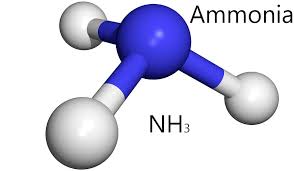The name comes from the Egyptian God Ammon, in whose temple according to legend, the first ammonia was made by burning camel dung.
 Ammonia (NH3) is an inorganic compound of nitrogen and hydrogen. It is at room temperature, a colorless, toxic and flammable gas with a typical strong smell. The gas is in large quantities (up to 33% by weight) soluble in water. This solution is known as ammonia, is alkaline, and an excellent cleaning agent that dissolves grease well.
Ammonia (NH3) is an inorganic compound of nitrogen and hydrogen. It is at room temperature, a colorless, toxic and flammable gas with a typical strong smell. The gas is in large quantities (up to 33% by weight) soluble in water. This solution is known as ammonia, is alkaline, and an excellent cleaning agent that dissolves grease well.
Never mix ammonia with bleaching and / or chlorinated products. Then arise some chemical fumes which are very harmful.
Ammonia is a gas.
Household ammonia is a solution of ammonia (gas) in in water. House, garden and kitchen Ammonia has a concentration of 5-10%.
(The confusion on that corpse with chlorine. Chlorine is a gas and chlorine based bleach is the (liquid) disinfectant that is used e.g. in the pool.)
The ammonia comes from the breakdown of amino acids by bacteria e.g. in the large intestine. In the liver, ammonia is converted into urea excreted in urine via the kidneys. The reaction can be reversed by the fermentation of urine in water. Also, in the ground as putrefactive bacteria (uro bacteria) to make ammonia of urea and fertilizer. This is converted by oxidation in the air and in the soil in nitric acid. This acidification is harmful to forest and nature.
